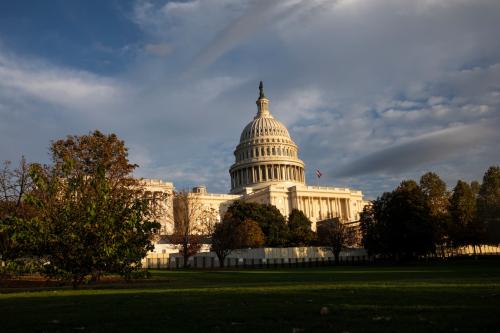From California to Capitol Hill, concerns over shoplifting have captured public attention across the United States and fueled momentum to further criminalize retail theft. Already, this punitive turn is producing serious consequences for communities. Last April, for instance, a man in San Francisco was shot by a security guard who accused him of stealing from Walgreens. In November, the Albuquerque, N.M. police killed a man accused of shoplifting from Kohl’s as part of their increased patrols to combat retail theft. And just last month, police officers killed a Virginia man suspected of stealing sunglasses at a Fairfax County shopping plaza.
As cities seek to rebuild from pandemic-era disruptions that temporarily hollowed out key commercial corridors and disadvantaged both large and small retailers, a widespread narrative has taken hold that retail theft is exploding and causing store closures in cities nationwide. Large corporations such as Target, CVS, and Walgreens have fueled this narrative by suggesting that retail theft is the major reason for closures. Policymakers are responding in kind, with several states passing or introducing legislation to impose harsher penalties for retail crime.
While there is a clear need to support businesses as they seek to recover from a tumultuous few years, the problem with the current retail theft crackdown is that it is not based on actual crime trends nor the evidence on what works to reduce theft. At the end of the day, the policy mistakes made now could engender literal life and death consequences for communities.
The fiction: Retail theft myths
There are three primary problems with the current retail theft narrative, which require policymakers’ and the public’s attention.
The first is a big one: Existing data on retail theft is highly unreliable and imprecise. First, “retail theft” is not an independent category reported by most police departments. Moreover, the terms increasingly used by industry and government officials—“organized retail crime” or “organized retail theft”—have no consistent legal definition across states and often encompass broader crimes such as cargo and employee theft (which are already associated with more severe sanctions). Even the California Retailers Association has acknowledged a lack of comprehensive and reliable data on retail theft.
The second is that shoplifting in major cities did not actually spike in the ways that media has reported. According to the Council on Criminal Justice, only 24 cities consistently reported shoplifting data over the past five years, and of those cities, shoplifting decreased in 17. Moreover, looking across all 24 cities, the prevalence of shoplifting in 2023 remained below 2018 and 2019 levels. Even San Francisco—which has often been cited as having a “shoplifting epidemic”—saw a 5% decline in shoplifting between 2019 and 2023.
Finally, corporate claims are not holding up to scrutiny, and are being used to close stores that are essential assets for many communities. For instance, the CEO of Walgreens has acknowledged that perhaps retailers “cried too much last year” and overspent on security measures that failed to reflect real needs. And although the National Retail Federation said that “organized retail crime” drove nearly half of all inventory losses in 2021, the group later retracted its claim; it now no longer attaches a dollar amount to money that is lost due to retail theft. And in memorable cases, major retailers have chosen to maintain stores with much higher rates of crime, while closing others.
The facts: The consequences of the retail theft panic could be dire
It should be a promising sign for many retailers and communities that the trend of widespread retail theft is greatly exaggerated. Unfortunately, many local and state government officials are in the midst of passing new policies in response to this exaggeration, without letting the evidence lead. For example, Florida recently passed legislation to make “organized retail theft” a felony, despite the fact that Florida cities with reliable data have seen sharp decreases in shoplifting—with St. Petersburg experiencing a 78% decline between 2019 and 2023.
The consequences for communities could be dire. Years of extensive research demonstrate that neither prosecuting low-level offenses nor increasing punishments based on second or third offenses meaningfully deters crime. A definitive analysis of 116 studies showed that incarceration does not deter people from committing future crimes and, in fact, incarceration for short periods can actually make someone more likely to be arrested and commit crimes later (due to heightened barriers to securing employment, identification, housing, and other basic services necessary to successfully reenter society).
While retailers are rightfully concerned about reducing theft in their stores, the current policy responses could have long-lasting negative consequences on communities—which, over the long-term, will make crime worse. Take the tragic events unfolding in Texas, where low-income residents are dying in jail for minor crimes such as stealing frozen meat or lawn equipment, while the judicial system remains strained and unable to provide proper defense for those not yet sentenced.
Evidence-based solutions to address retail theft and rebuild local economies
For policymakers concerned about theft, there are several promising strategies proven to do so without the negative consequences of the current punitive turn. Three such strategies are:
- Refocus efforts to center consumer protection, while holding online marketplaces responsible for third-party sales. Fully addressing organized theft requires directly combatting the financial incentives that drive this activity, and understanding that third-party resale of online goods is, most fundamentally, a clear issue of consumer protection. Policymakers should focus on efforts that hold online marketplaces responsible when third-party sellers sell stolen wares. As a starting point, they could engage federal agencies, including the Consumer Financial Protection Bureau, to understand and address how third-party resales jeopardize consumers in certain sectors or product areas and explore further regulations on online marketplaces to make it harder to sell stolen goods.
- Fully support and train retail workers. Retail workers are on the frontlines of theft prevention while simultaneously navigating a swiftly changing and precarious industry impacted by the rise of self-checkout and contactless delivery. Fully training and supporting retail workers is therefore a critical piece of addressing this issue. Indeed, some major CEOs have drawn throughlines between low retail theft and having well-trained, well-compensated staff who are bought into company success. To do so, policymakers could pursue policies that increase worker compensation and ownership, including minimum wage increases, workplace protections, and supports for businesses that wish to increase employee ownership or adopt cooperative models. Additionally, they could incentivize federal agencies and other bodies, including the Occupational Safety and Health Administration, to engage retailers regarding their workplace safety and training policies and how they can strengthen those efforts.
- Deploy proven, evidence-informed interventions to improve community safety while addressing poverty and precarity in our communities. Ultimately, to the degree that shoplifting occurs at a community and individual level, effective solutions must address the root cause of such thefts: financial precarity. Many communities are still reeling from the COVID-19 pandemic, and the expiration of pandemic aid—alongside rising inflation—has jeopardized our most vulnerable families in particular. Policymakers should consider evidence-informed ways to help families meet their basic needs. Indeed, evidence shows that a broad range of preventative investments—from Medicaid expansion to summer jobs, SNAP funding, public school funding, guaranteed income, expanded access to substance abuse treatment, the number of nonprofits, decreases in inequality, and increases in the minimum wage—can serve to reduce property crime. See this report and this evidence brief for more information regarding evidence-informed safety solutions.
The challenges facing businesses and local economies in the years since the pandemic are complex and require serious attention and care from policymakers. But in doing so, elected officials must follow the evidence on what works to reduce retail theft while respecting the dignity of human life. Evidence-based tools exist to help both retailers and residents rebuild from the pandemic, and it is imperative that no more lives are lost for stealing things like food, sunglasses, and basic necessities as cities seek to rebuild.
The Brookings Institution is committed to quality, independence, and impact.
We are supported by a diverse array of funders. In line with our values and policies, each Brookings publication represents the sole views of its author(s).





Commentary
Retail theft in US cities: Separating fact from fiction
March 6, 2024